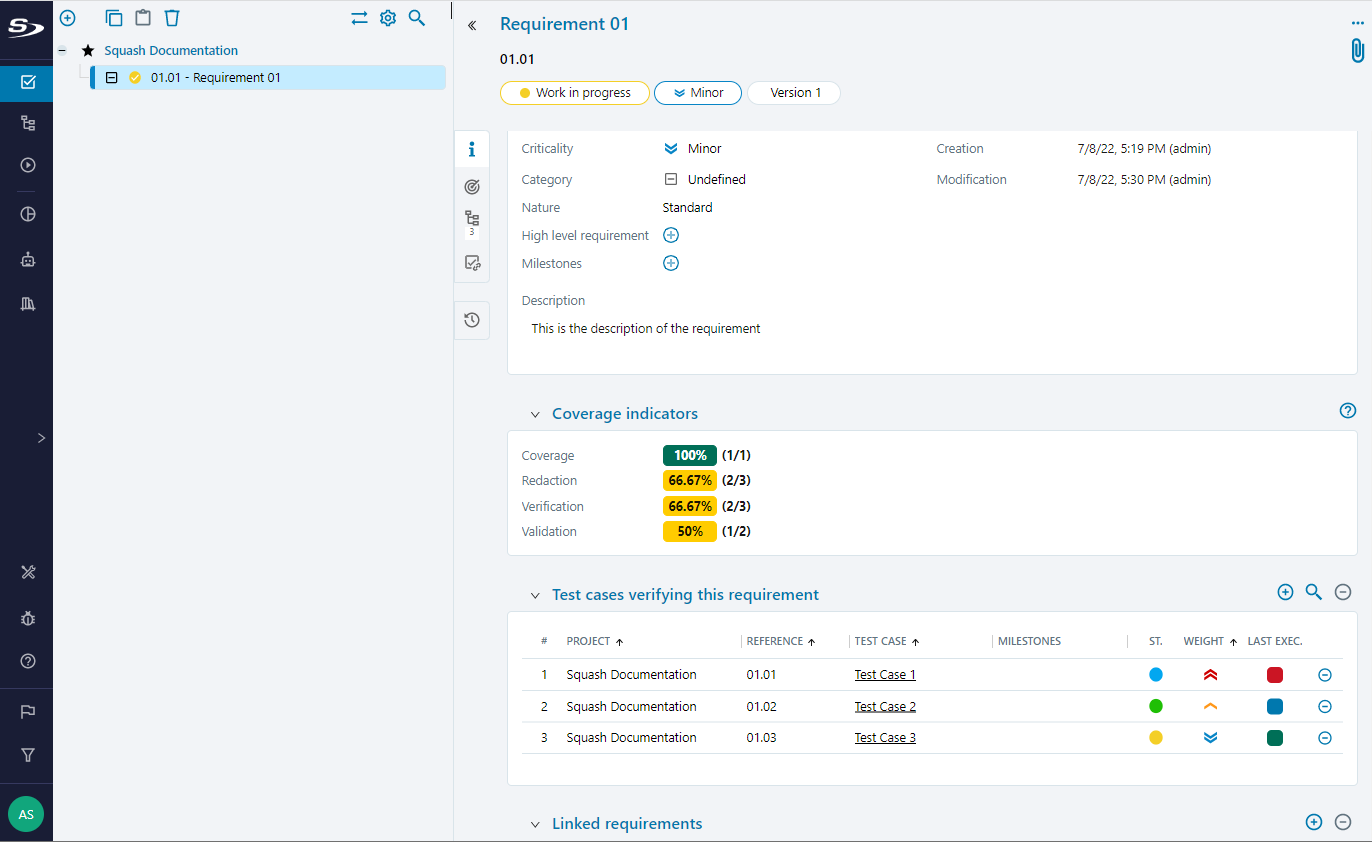Follow requirement coverage and validation
The Coverage indicators block enables to follow the coverage, redaction, verification and validation rates of a requirement.
Here is the definition of each indicator:
- Coverage rate: indicates if the requirement and its children are covered by at least one test case;
- Redaction rate: indicates the percentage of test cases being at the "Under review" or "Approved" statuses, among all the test cases covering the requirement or one of its children;
- Verification rate: indicates the percentage of test cases that were executed, by taking into account only their last execution, among the test cases covering the requirement or one of its children;
- Validation rate: indicates the percentage of test cases that were executed with a successful execution status ("Passed" or "Settled"), by taking into account only their last execution, among the test cases covering the requirement or one of its children;
Coverage indicators of a requirement
When a requirement is verified by several test cases, here is how these rates are calculated:

Coverage rate
The coverage rate indicates if the requirement is covered by at least one test case, no matter its status. For a requirement without children, this rate will always be 100% if the requirement is covered by at least one test case, or 0% if is not covered by any test cases. The coverage rate is mostly relevant for requirements with children and high level requirements. It shows which of the parent requirement and/or its children are covered by test cases.
Redaction rate
The redaction rate depends on the writing status of each test case verifying the requirement. Thus, among the three test cases verifying this requirement, only two of them have a "Under review" or "Approved" writing status. This rate is automatically updated when the test cases' writing status is modified.
Verification rate
The verification rate indicates the number of executed test cases, no matter their execution status. For this requirement, the three test cases verifying the requirement are in an execution plan, but only two of them have been executed ("Ready" and "Running" statuses are not considered as executed). This rate is automatically updated when a test case is executed.
Validation rate
The validation rate indicates the number of passed test cases ("Passed" or "Settled" statuses) among the executed tests cases. For this requirement, among the two test cases, only one of them has a "Passed" status. This rate is automatically updated depending on the execution status applied to test cases during the execution process.
Coverage indicators of a requirement with children
For a requirement with children (hierarchy in the library), the coverage indicators of the parent requirement include in their calculation the coverage, redaction, verification and validation rates of its children.
The Coverage indicators block of the parent requirement displays more information.
The rates are defined as followed:
- global rates: cumulative rates of the parent requirement and its children;
- parent requirement rates only;
- cumulative rates of the children requirements.
The Coverage indicators of a parent requirement are displayed as followed:

In this example, the requirement has two children. The parent requirement is verified by three test cases and each of its children are verified by one test case.
The parent requirement rates (This requirement column) calculation is identical to the previous example.
The children requirements rates (Its children column) have to be red like this:
- The two children requirements are each covered by at least one test case;
- Only one of the two test cases covering the children requirements has either a "Under review" or "Approved" writing status;
- Both of these test cases have been executed;
- Only one of the two executed test cases has a "Passed" status;
The global rates in the first column are cumulative rates of the parent requirement and its two children. The rates are calculated based on the summed values.
Coverage indicators of a high-level requirement
For a high-level requirement, the coverage, redaction, verification and validation rates work the same way as a requirement with children. The only difference is that the rates include the standard requirements, no matter how they were linked to the high-level requirement (through a hierarchy in the library or with direct links).
The coverage indicators of a high-level requirement are defined as followed:
- global rates: cumulative rates of the high-level requirement and its linked standard requirements;
- high-level requirement rates only;
- cumulative rates of the standard requirements linked to the high-level requirement.

The high-level requirement rates must be red like this:
- The high-level requirement is covered by at least one test case;
- Among the three test cases covering the high-level requirement, only two of them have either a "Under review" or "Approved" writing status;
- Two of the three test cases have been executed;
- Only one of them has a "Passed" status.
The linked standard requirements rates have to be red like this:
- The two linked standard requirements are each covered by at least one test case;
- Among the two test cases covering the two linked standard requirements, only one of them has either a "Under review" or "Approved" writing status;
- These two test cases are in an execution plan and have been executed;
- Only one of the two executed test cases has a "Passed" or "Settled" status.
The global rates in the first column are cumulative rates of the high-level requirement and its two linked standard requirements. The rates are calculated based on the summed values.
Learn more
To learn more about the high-level requirements, visit the page Manage high-level requirements